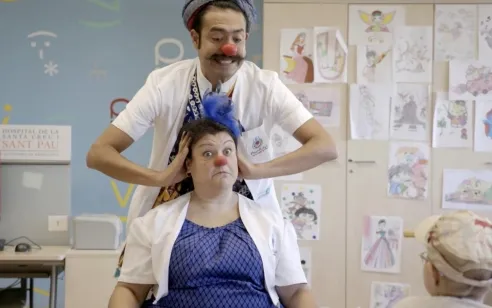
Is art a therapy? From my experience I can say it isn’t. Nevertheless, it does help communication processes, it relaxes the patients, it invites them to evade and also it helps them to meet their inner selves.
I am an actress, a storyteller and a playwright. My workspaces can be up on stage, in a library, out in the streets or sitting at my desk. When I studied performing arts, I never imagined I might end up working in a hospital. And yet, this is what has happened. In hospitals I have told stories, and directed scenes. Side-by-side with health workers and patients, we have written stories and poems, we’ve played, we’ve sung, we’ve laughed and we’ve enjoyed artistic activities.
Conquering this place full of prohibitions, norms and protocols has been a daring battle. There are many cultural associations, artists and volunteers who have found a space in hospitals. They’ve done this by proving, through their actions, that art is an unquestionable way of communication between disease and health. It is a vehicle that allows us to bring into our lives, in different ways, everything that surpasses us: pain, failure and death.
Art allows us to symbolize without explaining. It is an intimate action and also an expansive one, that allows us to gaze at emotions through its codes. Feelings that hide behind a diagnosis, an uncertainty and waiting.
When one practices an artistic activity in a hospital, this process is able to transform moments of stress into poetic moments. When we create, our imaginary universe changes the order of the rules, hierarchies fade away, and new norms emerge as a lifesaver amidst tension and rigidness. It’s like opening the windows in a closed and stuffy space beheld by fear. You breathe. You enter into a game feeling one way, and you go back to normality feeling distracted and imbued by the aura of creation.
The game, the seed of all artistic activity, is a powerful mediator between what is real and what is imaginary and, especially, a producer of poetry. It allows us to be someone different, to transform space and time. Long waiting is grateful for those moments when a game appears and takes us off to a “different reality”.
Reading, acting, painting, sculpting, playing an instrument…they are all activities that are not usually a part of the pathway we would imagine when in a hospital. Nevertheless, when we are in a crisis, practicing or receiving art in healthcare spaces may bring back to life the process of catharsis that brings back into humans the desire to connect with others. It makes you less vulnerable.
Artistic expression is an activity that, from its own language, gives us the opportunity to communicate without limits, of being intensely more human, intensely strong, and intensely fragile.
When a hospital opens its doors to a group that aims to favour conviviality, socialization and bonds, it’s not only the patients who benefit, but also their family and hospital staff. It allows patients to be once again, it relieves the stigma of “being” ill or suffering from a disease. For hospital staff, it frees them of their fixed roles, it gives them the opportunity to show themselves and, more importantly, it allows them to carry out their professional task with patients that are more relaxed, and jollier. And in doing so, what in principle was just a form of support, becomes a necessity.
A need that we become growingly aware of. Even when a pandemic hits our healthcare system, we think about the emotions that are repressed in times of an emergency. We know that art can help reconcile these emotions, make them blossom and turn them into a fruit that can feed our strengths.
Is art a therapy? From my experience I can say it isn’t. Nevertheless, it does help communication processes, it relaxes the patients, it invites them to evade and also it helps them to meet their inner selves. When art walks into a hospital it changes everything around it. It is not complementary to a treatment or a therapy. Art is therapy, art is health.



Add new comment